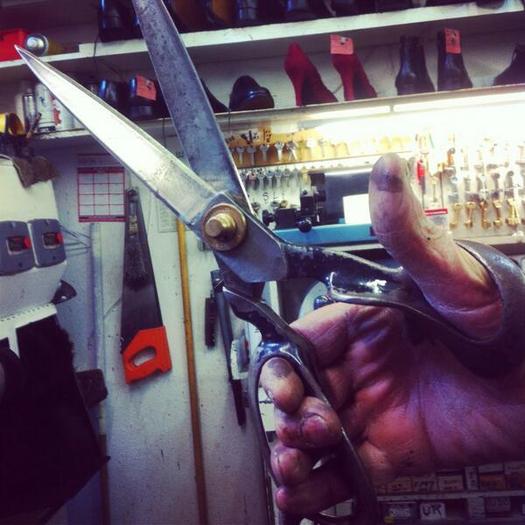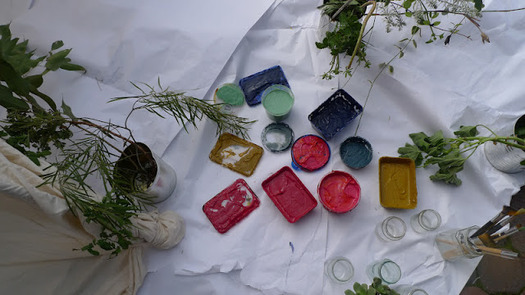
April 2, 2014
Keep Your Stuff Alive
The Tending and Grooming Station (below) is a wondrous collection of combs, brushes and other obscure (to me) gadgets. They are used to primp and revive pre-loved sweaters and cardigans that have been disfigured by bobbles and pilling – those unattractive fuzz balls that appear when short fibers misbehave on woolen garments.

Every object has a dark side — and that’s especially true in fashion. Two-wash-two wear tea shirts have a devastating impact on watercourses, air quality, soil toxicity, and human and ecosystem health, in many parts of the world.
It is one thing to draw attention to the hidden costs of fashion — quite another to figure out what to do about them. Exhortations to “buy less, wash less” are little match, on their own, for a global system whose very survival depends on perpetually growing material and energy throughputs.
In London last week, at an event called Craft of Use, 200 professionals explored the questions: What would fashion be like if it was more than a an act of consumption with no meaning beyond the point of sale? What kind of system would improve the quality of our fashion experience without increasing the quantity we consume?
The main input to our our discussions was a remarkable new archive of 500 stories, collected by designers and artists around the world, in which a sustained attention to wearing, tending and caring for clothes is is a source of satisfaction and meaning.
Matter in motion
For Kate Fletcher, who conceived Craft of Use, a key learning from these stories is that “cared-for clothes are not static objects, but matter in motion”. The relationship of the global fashion industry to its products ends, abruptly, at the point of purchase. People who care for their clothes through time, by contrast, do so in what Fetcher named a “a lifeworld that is itself a source of meaning”. A second lesson: People who connect with their clothes through time are more likely to connect with their makers, too, and with the ecosystems from which their materials come.
Jonathon Porritt, founder of Forum for the Future, agreed that the global fashion system continues to devour everything in its path, but suggested we take comfort from the fact that ‘things are getting worse more slowly”. He cited a range of initiatives as evidence that the hidden costs of fashion are no longer being ignored by industry: Marks & Spencer’s commitment of zero fibre to landfill; Nike’s coalition against toxins; the Better Cotton Initiative; Worn Again; the Sustainable Apparel Coalition
There was broad agreement, in discussion, that these industry coalitions can make a far bigger difference than a thousand tiny eco labels. But there was also a sense that their do-less-harm approach is compromised by a structural weakness: it does not question the imperative of economic growth.
Substantial resources and intelligence are being thrown at the problem of fashion waste and environmental impacts, but a core dilemma remains: A steady decline in environmental impact per garment – making products “greener every year” — leaves social and living systems worse off when the firm remains committed to growth.
A commitment to growth is not an ethical failing on the part of evil capitalists: It is the necessary behaviour of all commodity systems. As industry expert Lynda Grose explains it in a forthcoming book, “when a fibre such as cotton is grown industrially, as a commodity, it’s the logic of the market (my emphasis) that drives up production and drive down costs”. Farmers and the land both have to suffer, in other words, or the system is not doing its job.
A commodity system knows no place. It can’t. Its behaviour is shaped by numbers, not by context. Materials, when treated as a commodity, are not seen, or felt, by people managing the system. The living produce of the land, for them, is inert, abstract, experienced only as digits on screens.
Open Source Seams
Even where there’s a will to care for clothes, the global system puts practical obstacles in its way. In her project The Seam Decoder, Anja Crabb discovered that clothes from the 1950s and 1960s were much easier to adapt than they are today. Their bigger seam allowances made it possible adapt the garment as one’s body and the passage of time – or cake – interacted. Yes, those 1950s garments were mass-produced, but their design allowed for adjustment by the owner. Today’s seam edges are bound together all in one go, in a process called overlocking, that leaves them both narrower and harder to unstitch.

Keep Your Stuff Alive
Reconnecting with the neglected qualities of material, it emerged, is a key to system transformation. For the global system, the things around us are lifeless, brute, and inert. Trained into this perception of the world, we fill up our houses, land and oceans with junk. Discarded artifacts, electronic devices, clothes, bags, papers, bottles, bottles? They’re just stuff.
For Sabrina Mahfouz , our poet in residence for the day, the lesson is simple: “Keep Your Stuff Alive”.
The idea that things might be ‘vital‘ was once commonplace. For the Roman philosopher Lucretius, in his epic work On the Nature of Things, everything is connected in a world of matter and energy. That sense of things as vital is re-emerging today. For one contemporary successor to Lucretius, Timothy Morton, ‘there is more to things today than what we know about. Life forms and non-life forms are entangled with each other inextricably”.
Radical philosophers, and fashionistas, seem to be converging. The makers and clothes-carers featured in Craft of Use are signals that a life-affirming relationship with clothes is re-emerging from the wastelands of modernity.

(Above: In Grasslands, Emma Lynas connects garments to the earth literally, by extracting colour from her agricultural grassland in Victoria, Australia. She collects eucalyptus leaves, wild thyme, cedar berries and Aleppo pine needles – and simmers them with strips of hemp. The result is a range of summer hues: straw, gold and bronze.
After the event, I walked down London’s Oxford Street. On earlier visits one has felt like an extra in the film The Damned; hordes of people driven by satanic impulse to spend borrowed money on bag loads of junk. On this Wednesday evening, the pavements were as busy as usual – but the shops themselves were eerily empty. Another sign, perhaps, that the change we yearn for is already happening?
Footnote
Craft Of Use was the latest phase of research and design activity in the Local Wisdom project; it is originated and led by Kate Fletcher from the Centre for Sustainable Fashion at the London College of Fashion. Craft Of Use itself involved a network of seven international partners and was funded by The Leverhulme Trust. A book by the same team — The Routledge Handbook of Sustainability and Fashion, edited by Kate Fletcher and Mathilda Tham – will be published in August.
Observed
View all
Observed
By John Thackara
Recent Posts
A quieter place: Sound designer Eddie Gandelman on composing a future that allows us to hear ourselves think It’s Not Easy Bein’ Green: ‘Wicked’ spells for struggle and solidarity Making Space: Jon M. Chu on Designing Your Own Path Runway modeler: Airport architect Sameedha Mahajan on sending ever-more people skyward



